1.
Everyday life
2.
British Humour
3.
Units of measure
Everyday life
|
Licence plate (front and back)
different colour on the two ends, no flag or sign indicating the country. |

 |
|
Bentley
Motors Limited and Rolls-Royce Motor Cars Limited are (were) manufacturer of
luxury automobiles founded in England in 1919 and 1904 and recently bought
by BMW and Volkswagen respectively. |
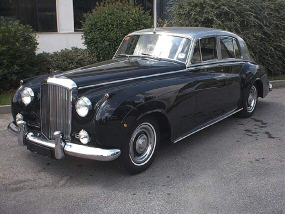
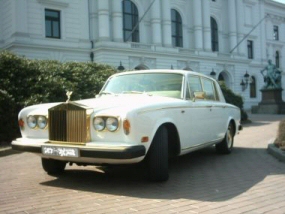 |
|
The steering wheel on the right side and...
Driving on the left side...
|
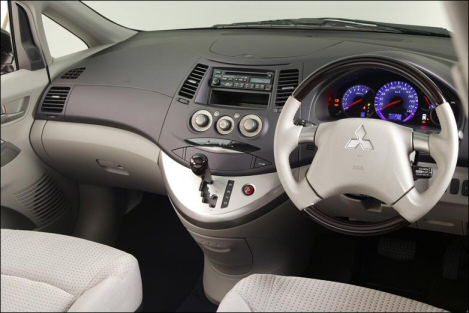 |
|
You should look right first if you want to cross the
street safely. This simple safety sign throughout the
UK is a reminder to tourists that they need to look the 'other' way before
crossing so they don't get hit. |

 |
|
Telephone box
The telephone booth became common in the 1910s. |
 |
|
Post box
Left: Pillar box... have been in use since 1855,
only 15 years after the introduction of the first
penny post.
Right: Lamp box... the smallest post boxes used
by the Royal Mail in the UK |
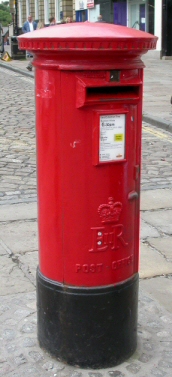
 |
|
Plug
Plugs are considerably bigger in size in the UK.
You definitely need an
adaptor if you want use your electric device (bought in Hungary) in the UK. |
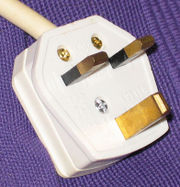
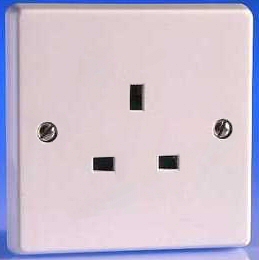 |
|
Sink
Try to wash your hand
without burning or freezing yourself! Many households still have a
separate tap for cold and hot water. The UK houesholds were among the
first in Europe to have running water installed in their homes but they seem
to have got stuck in time... |
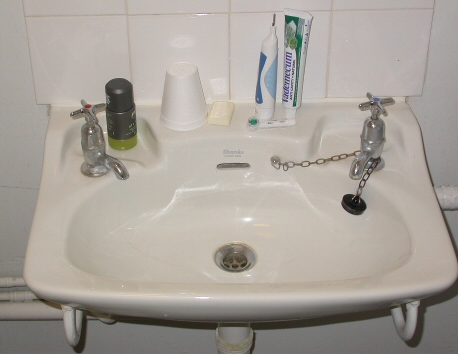 |
What is British ‘humour’?
British humour has a reputation for being puzzling to non-British speakers of English. The British sense of humour is often a source of
mystification for other nations, and visitors to Britain may claim that British
humour is incomprehensible; however, possessing ‘a sense of humour’ is usually
regarded as a favourite virtue of the British.
It is difficult to pinpoint the exact components of British ‘sense of humour’, but
it may be loosely defined as an attitude of mind which is readily responsive to
the incongruous and ridiculous.
General features characteristic of
'British humour':
§
Puns: are jokes that play with words.
Generally these do not translate into other languages.
Why did the man throw the clock
out the window? He wanted to see time fly!
Sometimes when I'm bored, l make
spaghetti just to PASTA time away.
In London, one man to another:
A: "You know, my daughter has married an Irishman"
B: "Oh, really?"
A: "No, O'Reilly"
§
Nonsense:
has its origins in the writings of Lewis Carroll and Edward Lear.
Jim was speeding along the road one fine day when the
local policeman, a friend of his, pulled him over. "What's wrong, Eric?" Jim
asked. "Well didn't you know, Jim, that your wife fell out of the car about five
miles back?" said Eric. "Ah, praise God!" he replied with relief. "I thought I'd
gone deaf!"
At an auction in Manchester a wealthy American announced
that he had lost his wallet containing £10,000 and would give a reward of £100
to the person who found it.
From the back of the hall a Scottish voice shouted, "I'll give £150!"
§
Black
humour: main features of black humour can already be found in the drama of the
Elizabethan age.
§
Eccentricity
Themes:
§
Smut and innuendo
with sexual and scatological themes. Bawdy or slapstick comedy can trace its roots
back to Chaucer and Shakespeare, and continued through the early films of
Charlie Chaplin, the ‘Carry On’ film series of the 1960s and 1970s and is found
today in characters such as the long-running ‘Benny Hill Show’.
§
Disrespect to members of the
establishment and authority
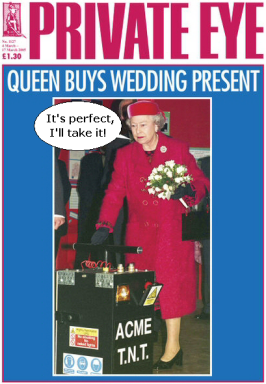 The
caption (March 4, 2005 cover of Private Eye - satirical magazine) refers
to the wedding of Prince Charles and Camilla Parker-Bowles.
The
caption (March 4, 2005 cover of Private Eye - satirical magazine) refers
to the wedding of Prince Charles and Camilla Parker-Bowles.

§
The absurd:
British humour has an everpresent but hard to define appreciation of the absurd,
originating in programmes like ‘The Goon Show’, a radio comedy of the 1950s and
continuing in television’s legendary ‘Monty Python’s Flying Circus’ and ‘Fawlty
Towers’.
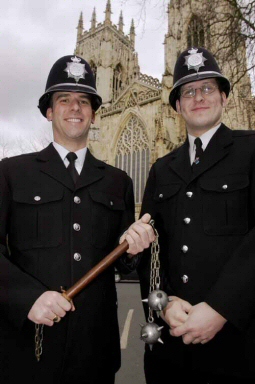

§
The banality of everyday life
§
The 'war' between parents/teachers and their children
§
The British class system, especially pompous or dim-witted members of the
upper/middle classes or embarrassingly blatant social climbers
§
The lovable rogue, usually an impoverished working class lad trying to make
some money and better himself
§
The embarrassment of social ineptitude
§
Harsh sarcasm and bullying
§
Affection for the eccentric, especially when coupled with
inventiveness. The humorous qualities of Dickens’ novels lie in the fact that
many of his characters are ‘larger than life’ - their appearance and personal
qualities are highly exaggerated. This is also true today of many of our
favourite television comedies, where the lead characters are often wonderfully
eccentric and ‘over the top’.
Units of measure
The basic
unit of English length is the yard, which was originally taken as
the distance between Henry I's (1068-1135) nose and the tip of his outstretched
arm.
Lengths
|
1 nail |
= 2¼ inches |
|
4 inches |
= 1 hand |
|
12 inches |
= 1 foot |
|
3 foot |
= 1 yard |
|
5.5 yards |
= 1 rod |
|
6 foot |
= 1 fathom |
|
22 yards |
= 1 chain |
|
100 links |
= 1 chain |
|
10 chains |
= 1 furlong |
|
8 furlongs |
= 1 statute mile |
|
6080 foot |
= 1 nautical mile |
|
|
|
|
1 yard |
= 91.44 cm |
|
1 foot |
= 30.48 cm |
|
1 inch |
= 2.54 cm |
The basic
unit of weight in the British system is the grain - originally
based on the weight of a grain of barley (but note that money was based on the
grain of wheat - and that three grains of barley weigh the same as four of
wheat). This grain is the troy grain - there is no other weight of the same
name.
The weight of one grain is constant throughout the many different systems of
British weights. As you will see below, the ounce and pound are anything but
contstant, but have altered to meet circumstances over a period of over a
thousand years.
The avoirdupois pound is the pound in general use today. As its name
implies, it was intended to be used for weighing heavy goods. This pound is of
7000 grains, and is split into 16 ounces (each, therefore of 437.5 grains). Each
ounce is divided into 16 drams (which according to my calculator equals to 27.34375 grains
each - much more fun than metric isn't it?).
avoirdupois weights
|
16 drams |
= 1 ounce |
|
16 ounces |
= 1 pound |
|
7 pounds |
= 1 clove |
|
14 pounds |
= 1 stone |
|
28 pounds |
= 1 tod |
|
112 pounds |
= 1 hundredweight |
|
364 pounds |
= 1 sack |
|
2240 pounds |
= 1 ton |
|
2 stones |
= 1 quarter |
|
4 quarters |
= 1 hundredweight |
|
20 hundredweight |
= 1 ton |
|
|
|
|
1 ounce (oz) |
= 373.2 g |
|
1 pound |
= 0.4536 kg |
|
1 ton |
= 1016.05 kg |
The basic
unit of volume in the British system is the gallon.
The Imperial gallon is defined as the volume of 10lb (pound) of water at 62°F, which
works out at 277.4194 cubic inches.
volumes
|
60 minims |
= 1 fluid drachm |
|
8 fluid drachms |
= 1 fluid ounce |
|
20 fluid ounces |
= 1 pint |
|
4 gills |
= 1 pint |
|
2 pints |
= 1 quart |
|
4 quarts |
= 1 gallon |
|
2 gallons |
= 1 peck |
|
4 pecks |
= 1 bushel |
|
8 bushels |
= 1 quarter |
|
36 bushels |
= 1 chaldron |
|
|
|
|
1 pint |
= 0.568 litre |
|
1 gallon |
= 4.546 litre |
Ale measures
|
9 gallons |
= 1 firkin |
|
4 firkins |
= 1 barrel |
Wine measures
|
52 ½ gallons |
= 1 hogshead |
|
26 and 2 thirds fl. oz. |
= 1 bottle |
J,
but true:
Before 1824, a hogshead was 63 wine gallons (you must understand that the
physical size of a hogshead didn't change, just the way that it was measured).
The wine gallon is the Queen Anne (1707) gallon, as used ever since in the US of
A (the colonies declared independance in 1776). Note in passing that the US
bushel is for dry measure only, and based on the William III gallon (1696), and
so the two are incompatible with each other.
® Thank God for the SI system!
Temperature: The Fahrenheit system has freezing point at
32°, and boiling point at 212°. Custom has it that zero degrees Farenheit was
chosen as the lowest temperature then attainable, and 100°F as body temperature.
There are 180 degrees between 'freezing point' and 'boiling point'.
To convert a Fahrenheit temperature to centigrade, do the following:
1) Subtract 32
2) Multiply by 5
3) Divide by 9
Try it with 66°F - you should get 19°C. To convert C to F, just do it the other
way round!
 vocabulary:
vocabulary:
sources:
Monty Python clips:
http://seehere.blogspot.com/2004/10/monty-python-videos-and-stuff.html
credits:
The text was extracted from...
1.
Units of measure: http://home.clara.net/brianp/
2.
British humour:
Wikipedia The Free Encyclopedia
under
GNU Free Documentation Licence.
3.
Photo of
Look right
©
Eve Andersson









 The
caption (March 4, 2005 cover of Private Eye - satirical magazine) refers
to the wedding of Prince Charles and Camilla Parker-Bowles.
The
caption (March 4, 2005 cover of Private Eye - satirical magazine) refers
to the wedding of Prince Charles and Camilla Parker-Bowles.
